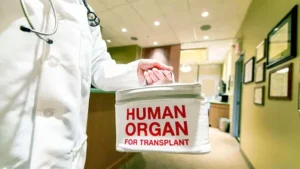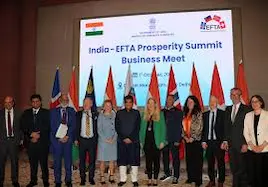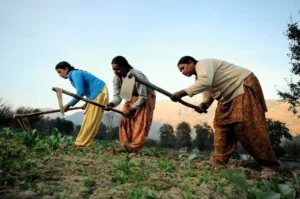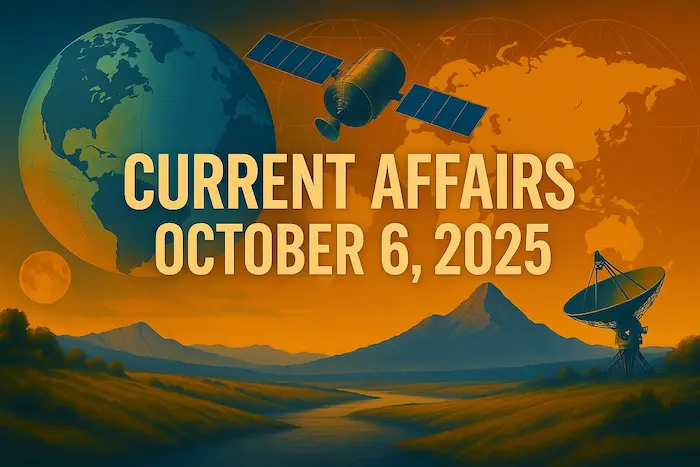1. Organ Donation in India: Challenges and the Way Forward – Governance

Why in News?
Despite India witnessing a high number of road accident and ICU-related deaths, the rate of deceased organ donation remains critically low. A recent national survey highlights systemic barriers like inadequate physician training, low awareness, and inefficiencies in brain death certification, all of which impede organ donation.
Key Takeaways
India ranks 3rd globally in total transplants, but its organ donation rate remains very low.
Only 1,128 deceased donors were recorded in 2024, mostly from six southern states.
Living donors (15,000+) far outnumber deceased donors, reflecting poor institutional systems and awareness.
Organ Donation in India – The Numbers
| Indicator | India | Developed Countries |
|---|---|---|
| Donors per million population (2024) | <1 | Spain (~48), USA (~36) |
| Kidney transplant waiting list | ~63,000 | – |
| Liver transplant waiting list | ~22,000 | – |
| Deceased donors (2024) | 1,128 | – |
| Living donors (2024) | 15,000+ | – |
Key Challenges in Organ Donation
1. Low Awareness and Misconceptions
Many people are unaware of organ donation procedures or fear body mutilation.
Cultural and religious beliefs create psychological barriers.
2. Family Refusal
Families often refuse consent, even when the deceased had pledged donation.
Lack of counselling and emotional support during bereavement exacerbates refusals.
3. Brain Death Certification Issues
Crucial step for deceased donation.
AIIMS study:
Less than 50% of doctors trained in brain death certification.
Though 96% knew of the apnea test, many skipped ruling out reversible coma causes.
4. Healthcare Infrastructure Gaps
Most government hospitals lack transplant coordinators and standardized ICU protocols.
Absence of dedicated organ procurement organizations (OPOs) in most states.
Government Initiatives and Reforms
Key Policy Measures
National Organ and Tissue Transplant Organisation (NOTTO):
Central agency to coordinate donations, maintain registries, and promote awareness.
Removal of Upper Age Limit:
Individuals of any age can now register as deceased donors.
Online Pledge Portals:
E.g., Jeevandan (Telangana), ROTTO-NOTTO registry
Green Corridors:
Facilitate faster transport of harvested organs across cities.
Way Forward: A Comprehensive Strategy
| Strategy Area | Action Needed |
|---|---|
| Awareness | Nationwide campaigns via schools, media, religious leaders |
| Training | Mandatory training in brain death certification for all ICU staff |
| Hospital Systems | Dedicated transplant coordinators in all tertiary care hospitals |
| Legal Framework | Simplify consent mechanisms; protect donor rights |
| Monitoring & Data | Real-time donor/recipient registries with regional data sharing |
Exam Connect – Possible Questions
Prelims
1. Which organization is responsible for coordinating organ transplant activities in India?
A. ICMR
B. National Health Mission
C. NOTTO
D. NITI Aayog
Answer: C. NOTTO
2. Which of the following statements is true regarding organ donation in India?
A. Living donors far outnumber deceased donors.
B. India has more than 30 donors per million population.
C. Only private hospitals can perform organ transplants.
D. Organ donation is permitted only up to the age of 60.
Answer: A. Living donors far outnumber deceased donors.
Mains
1. “Despite advancements in transplant technology, India continues to struggle with low organ donation rates.” Examine the key challenges to organ donation in India and suggest policy-level interventions to address them.
2. “Organ donation is not just a medical issue but also a societal and administrative one.” Discuss how governance reforms and public engagement can improve organ donation rates in India.
2. Preventive Detention and the National Security Act (NSA), 1980 – Polity

Why in News?
Prominent climate activist Sonam Wangchuk was detained under the National Security Act (NSA), 1980, while leading protests in Ladakh demanding statehood and inclusion under the Sixth Schedule of the Constitution.
This incident has brought fresh attention to the use and scope of preventive detention laws in India and their implications for civil liberties.
What is Preventive Detention?
| Type | Description |
|---|---|
| Preventive Detention | The detention of a person without trial based on suspicion that they may engage in acts threatening public order, national security, or essential supplies. |
| Punitive Detention | Detention after a legal conviction following due process of law, for crimes already committed. |
Preventive detention is anticipatory in nature, whereas punitive detention is reactive.
Constitutional Provisions (Article 22)
| Provision | Details |
|---|---|
| Permits Preventive Detention | Article 22(3) allows preventive detention even without trial in certain situations. |
| Detention Limit Without Advisory Board Approval | Up to 3 months |
| Beyond 3 months | Requires approval of an Advisory Board of High Court judges |
| Rights of the Detainee |
|
- Note: Article 22 is one of the few exceptions to Article 21 (Right to Life and Liberty).
Judicial Views on Preventive Detention
| Case | Key Ruling |
|---|---|
| Ameena Begum v. State of Telangana (2023) | Preventive detention must be exceptional, not routine. |
| Rekha v. State of Tamil Nadu (2011) | Preventive detention is a serious curtailment of liberty; must be used sparingly and justifiably. |
| Anukul Chandra Pradhan v. Union of India (1997) | The purpose is preventive, not punitive; aimed at state security, not punishment. |
National Security Act (NSA), 1980 – Explained
Background
Rooted in colonial-era laws like the Defence of India Act, 1915.
Post-independence laws:
Preventive Detention Act (1950)
Maintenance of Internal Security Act (MISA, 1971) – repealed after misuse during the Emergency.
NSA enacted in 1980 to prevent threats to defence, foreign relations, public order, or supply of essentials.
Key Provisions
| Feature | Details |
|---|---|
| Who can be detained? | Anyone whose actions may threaten national security, public order, or essential supplies |
| Detention Order | Acts like an arrest warrant; allows holding in special facilities |
| Grounds Communication | Must be shared with detainee within 5–15 days |
| Advisory Board Review | Must review the case within 3 weeks |
| Maximum Detention Period | 12 months (can be revoked earlier) |
| No Legal Representation | Detainees cannot have lawyers before the Advisory Board |
| Govt’s Discretion | Government can withhold certain facts from the detainee for security reasons |
Criticism and Concerns
Potential for misuse due to broad and vague powers.
Lack of judicial safeguards like open hearings or cross-examinations.
Used against activists, protestors, and dissenters, often leading to debates on civil liberties.
Undermines the principle of ‘innocent until proven guilty’.
Exam Connect – Possible Questions
Prelims
1. Under Article 22 of the Indian Constitution, how long can a person be held under preventive detention without approval of an Advisory Board?
A. 15 days
B. 1 month
C. 3 months
D. 6 months
Answer: C. 3 months
2. Which of the following laws governs preventive detention in India for reasons related to public order and national security?
A. Armed Forces Special Powers Act
B. National Investigation Agency Act
C. National Security Act, 1980
D. Public Safety Act
Answer: C. National Security Act, 1980
Mains
1. “Preventive detention laws are essential for national security but must be balanced with civil liberties.” Examine the constitutional, legal, and ethical dimensions of preventive detention in India.
2. “The National Security Act, 1980, has increasingly come under criticism for its misuse.” Critically analyse the relevance of NSA in today’s democratic framework and suggest possible safeguards against its arbitrary application.
3. India–EFTA Free Trade Agreement (TEPA) – International Relations

Why in News?
The India–EFTA Free Trade Agreement (Trade and Economic Partnership Agreement or TEPA) officially came into effect on 1st October 2025. This is a major step forward in India’s trade and investment diplomacy, offering market access, FDI opportunities, and deeper integration with the global economy.
What is the EFTA?
| Country | Member of EFTA |
|---|---|
| Switzerland | Member |
| Norway | Member |
| Iceland | Member |
| Liechtenstein | Member |
The European Free Trade Association (EFTA) is a regional bloc focused on promoting free trade and economic integration outside the European Union (EU).
About the India–EFTA TEPA
| Feature | Details |
|---|---|
| Signed | March 2024 |
| Came into effect | October 1, 2025 |
| Purpose | Boost trade, facilitate investment, and promote economic cooperation |
| Relation to other FTAs | Complements India’s FTAs with UAE (CEPA), Australia (ECTA), Mauritius, and others |
Key Objectives and Benefits
1. Market Access
EFTA offers 100% duty-free market access to India’s industrial and non-agricultural exports
Tariff concessions on processed agricultural products
2. Investment and Employment
EFTA countries committed to investing USD 100 billion over 15 years
Projected to create 1 million direct jobs in India
3. Institutional Support
EFTA Desk (operational since February 2025) as a single-window mechanism for investor facilitation and support
4. Regulatory Alignment
Harmonization of product standards and certifications to reduce compliance barriers
What are Free Trade Agreements (FTAs)?
FTAs are bilateral or multilateral agreements that reduce or eliminate tariffs, quotas, and non-tariff barriers on goods and services.
Aim to boost trade, attract FDI, and enhance economic cooperation.
India’s Gains from FTAs – With Examples
| Benefit | FTA Example | Impact |
|---|---|---|
| Market Access | India–UAE CEPA | 90% of Indian exports became duty-free; 12% rise in exports |
| FDI Growth | India–Australia ECTA | 25% increase in FDI post-agreement |
| Agri Exports | India–Mauritius CECPA | Boost in sugar and tea exports |
| Tech Transfer | India–Australia ECTA | Clean energy collaboration |
| MSME Boost | India–Singapore CECA | SMEs in IT & engineering gained global market access |
| Regulatory Alignment | India–EFTA TEPA | Simplified product certifications, reducing export costs |
Concerns with India’s FTAs
| Issue | Example / Impact |
|---|---|
| Rising Trade Deficits | India–ASEAN FTA led to $44B imports in FY23 vs stagnant exports |
| Non-Tariff Barriers | Delays in India–EU FTA due to data and IPR issues |
| MSMEs & Farmers at Risk | Rubber growers impacted by ASEAN FTA competition |
| Labor & Environment Clauses | EU’s Carbon Border Adjustment Mechanism may hurt Indian exports |
| Weak Dispute Resolution | Limited enforcement in India–ASEAN disputes on palm oil and machinery |
Steps India Can Take to Maximize FTA Benefits
1. Enhance Export Competitiveness
Focus on quality, branding, and innovation
2. Diversify Trade Partners
Negotiate FTAs with Africa, Latin America, and emerging Asia-Pacific economies
3. Support MSMEs
Provide better access to credit, digital platforms, and logistics networks
4. Upgrade Infrastructure
Expand ports, freight corridors, cold chains, and logistics hubs
5. Strengthen Standards Compliance
Training exporters to meet global product, labor, and environmental standards
6. Embrace Digital Trade Platforms
Promote e-marketplaces, virtual trade expos, and digital FTA usage portals
Exam Connect – Possible Questions
Prelims
1. Which of the following countries is not a member of the European Free Trade Association (EFTA)?
A. Norway
B. Switzerland
C.Austria
D. Liechtenstein
Answer: C. Austria
2. Under the India–EFTA FTA, EFTA countries have committed to an investment of:
A. USD 10 billion over 5 years
B. USD 100 billion over 15 years
C. USD 75 billion over 10 years
D. USD 50 billion over 20 years
Answer: B. USD 100 billion over 15 years
Mains
1. “Free Trade Agreements can serve as catalysts for economic growth, but also pose risks for vulnerable sectors.” Examine this statement in light of India’s FTA with EFTA.
2. “India’s trade strategy needs to balance global integration with domestic protection.” Discuss how FTAs like India–EFTA can be made inclusive and sustainable for all stakeholders.
4. Empowering Women in Agriculture – Economy

Why in News?
According to the Periodic Labour Force Survey (PLFS) 2023–24, women’s participation in agriculture has increased significantly.
However, the data also shows that nearly half of these women remain unpaid, exposing persistent gender inequalities in rural and agricultural employment.
Status of Women in Indian Agriculture
| Indicator | Data/Observation |
|---|---|
| Share of Women in Agriculture | Over 42% of total agricultural workforce (a 135% rise over the last decade) |
| Unpaid Family Workers | Increased from 23.6 million (2017–18) to 59.1 million (2024–25) |
| Regional Concentration | In Bihar and Uttar Pradesh, >80% of rural women work in agriculture; half remain unpaid |
| Ownership | Only 13–14% of land holdings are owned by women |
| Programmes Supporting Women | Mahila Kisan Sashaktikaran Pariyojana (MKSP), Kisan Credit Cards (KCC), and Self-Help Groups (SHGs) |
Feminisation of Agriculture – Causes
Male Out-Migration
Rural men are shifting to urban jobs (construction, transport, services), leaving women to manage farms.
Women now act as farm managers, cultivators, and labourers.
Growth of Contract Farming
Labour-intensive sectors (floriculture, tea, horticulture) prefer women for precision work and reliability, albeit at lower wages.
Patriarchal Norms
Women’s agricultural work often seen as “family help”, not professional labour.
Deep-seated gender roles undervalue their economic contributions.
Limited Non-Farm Opportunities
Low literacy, social restrictions, and limited mobility confine women to agriculture as one of the few viable livelihoods.
Systemic Barriers to Women’s Empowerment in Agriculture
| Barrier | Description |
|---|---|
| Wage Discrimination | Women earn 20–30% less than men; most are unpaid or underpaid family workers. |
| Exclusion from Decision-Making | Male-dominated agriculture departments and Panchayats marginalize women’s voices in policy and practice. |
| Machinery & Design Gaps | Farm tools (tractors, threshers) designed for men—physically unsuitable and financially inaccessible to women. |
| Double Burden of Care | Household responsibilities limit time for market work, training, and leadership. |
| Land and Identity Rights | Without land titles, women are treated as “helpers”, losing access to credit, insurance, and subsidies. |
Government Initiatives for Women Farmers
| Initiative | Focus Area |
|---|---|
| Mahila Kisan Sashaktikaran Pariyojana (MKSP) | Skill development, sustainable agriculture, collective bargaining |
| Self-Help Groups (SHGs) | Financial inclusion and entrepreneurship support |
| Kisan Credit Card (KCC) | Credit access for women cultivators |
| FPO Promotion Scheme | Women-led Farmer Producer Organisations for value-chain integration |
| Digital Sakhi & PM Digital Literacy Mission | Encouraging digital and financial literacy among women farmers |
Way Forward: Ensuring Empowerment of Women in Agriculture
1.Guarantee Market Access
Prioritize women-intensive sectors (tea, spices, dairy, handicrafts) under Free Trade Agreements (FTAs).
Facilitate women’s participation in exports, especially in organic and GI-tagged products.
2. Ensure Resource and Land Rights
Promote joint land ownership and title registration in women’s names.
Expand women-led FPOs and SHGs for collective strength and better bargaining power.
3. Promote Digital Inclusion
Expand e-NAM and create AI-driven local language tools like BHASHINI, Jugalbandi, and Digital Sakhi to boost literacy and access to agri-information.
4. Reduce Time Poverty
Establish creche facilities near farms, ensure clean energy access, and improve drinking water to reduce domestic drudgery.
5. Visibility and Recognition
Recognize women as farmers, not helpers in official records.
Use media campaigns and awards to celebrate women role models in agriculture.
Exam Connect – Possible Questions
Prelims
1. According to the PLFS 2023–24, what percentage of India’s agricultural workforce is constituted by women?
A. 25%
B. 35%
C. 42%
D. 50%
Answer: C. 42%
2. Which of the following schemes directly focuses on empowering women farmers through skill development and collective action?
A. PM-KISAN
B. Mahila Kisan Sashaktikaran Pariyojana (MKSP)
C. PM Fasal Bima Yojana
D. PM Krishi Sinchayee Yojana
Answer: B. Mahila Kisan Sashaktikaran Pariyojana (MKSP)
Mains
1. “The feminisation of agriculture in India represents both an opportunity and a challenge.” Examine this statement in light of the rising participation of women in agriculture as revealed by the PLFS 2023–24.
2. “Women farmers are the invisible workforce of Indian agriculture.” Discuss the barriers they face and suggest policy measures for ensuring their full economic empowerment.
5. India’s Evolving Strategy to Prevent Crowd Disasters – Governance
Why in News?
A crowd crush at a political rally organized by actor and Tamilaga Vettri Kazhagam (TVK) founder Vijay in Karur district, Tamil Nadu, led to the tragic death of 41 people.
Following the incident, Chief Minister M.K. Stalin announced a one-member commission headed by retired Justice Aruna Jagadeesan to investigate the causes and recommend measures for preventing such disasters in the future.
The government also intends to formulate new regulations for managing large public gatherings based on the commission’s findings.
Key Takeaways
A judicial commission was formed to probe the tragedy and suggest preventive measures.
Tamil Nadu plans to introduce new laws regulating public events and gatherings.
The incident has reignited a national conversation on crowd safety and management reforms.
India’s Evolving Framework for Crowd Management
1. National-Level Measures
a) Bureau of Police Research & Development (BPR&D)
Released Comprehensive Guidelines on Crowd Control and Mass Gathering Management (June 2025).
Emphasizes preventive crowd control, risk mapping, site design, and law enforcement coordination.
b) National Disaster Management Authority (NDMA)
Continues to enforce its 2020 Crowd Management Framework, focusing on:
Pre-event risk assessment
Defined entry/exit routes
Real-time monitoring
Communication systems and emergency protocols
c) Indian Railways Safety Manual (Revised 2025)
Introduced crowd control mechanisms at 60 major railway stations, including:
Holding zones and dispersal areas
Crowd density monitoring using CCTV and sensors
2.State-Level Reforms
| State | Recent Initiative | Key Features |
|---|---|---|
| Karnataka | Crowd Control (Managing Crowd at Events and Venues of Mass Gathering) Bill, 2025 | – Regulates political, cultural, and religious events. – District Magistrates empowered to cancel gatherings. – Organizers held legally accountable. |
| Uttar Pradesh | Guidelines for Managing Crowd at Events of Mass Gathering, 2023 | – Focuses on religious/cultural congregations. – Defines event risk levels and safety norms. |
| Gujarat | Institute of Disaster Management (GIDM) Training Materials | – Offers scientific methods for capacity calculation, evacuation plans, and volunteer coordination. |
| Uttarakhand | Temple Safety Protocols (2025) | – Introduced post-Haridwar stampede. – Mandates removal of encroachments, better exit routes, and safety audits. |
| Maharashtra | Nasik–Trimbakeshwar Kumbh Mela Authority Bill | – Authorizes temporary infrastructure for large religious events. – Introduces SOPs for fire and crowd control. |
3. Common Gaps
Most crowd management measures are advisory, not statutory.
Reactive enforcement after disasters instead of proactive planning.
Inter-agency coordination (police, fire, health) often remains weak.
Lack of uniform national law for mass gathering management.
Scientific Principles of Crowd Management
| Concept | Best Practice / Insight |
|---|---|
| Safe Density | Risk increases sharply beyond 5 people per square meter. |
| Design & Flow | Avoid bottlenecks, slopes, counter-flows to prevent pressure buildup. |
| Technology Use | Employ drones, AI-enabled cameras, and real-time sensors for crowd tracking. |
| Signage & Communication | Install clear directional signage and public address systems for crowd movement. |
| On-Site Preparedness | Ensure medical teams, first aid stations, and trained volunteers are deployed. |
| Emergency Response | Plan multiple exit routes, maintain open corridors, and train staff in evacuation drills. |
Safety Advice for Individuals in Crowds
Move diagonally toward less dense areas—avoid opposing crowd flow.
Protect breathing space by keeping forearms across the chest.
Avoid rigid barriers and steep slopes.
Do not stop for dropped items or videos.
If knocked down, roll sideways, shield head/neck, and get up quickly.
Exam Connect – Possible Questions
Prelims
1. Which agency released the Comprehensive Guidelines on Crowd Control and Mass Gathering Management in 2025?
A. NDMA
B. Bureau of Police Research and Development (BPR&D)
C. NDRF
D. Ministry of Home Affairs
Answer: B. Bureau of Police Research and Development (BPR&D)
2. According to scientific research, crowd risk escalates significantly when density exceeds:
A. 3 persons/m²
B. 5 persons/m²
C. 7 persons/m²
D. 10 persons/m²
Answer: B. 5 persons/m²
Mains
1. “Crowd disasters in India highlight a governance gap between advisory frameworks and enforceable safety laws.” Discuss the need for a national legal framework for crowd management in India.
2. “Scientific crowd management is essential to balance public safety with democratic freedom of assembly.” Examine the role of technology, institutional training, and local administration in preventing crowd disasters.
6. Payments Regulatory Board (PRB) – Economy
Why in News?
The Reserve Bank of India (RBI) has constituted a new six-member Payments Regulatory Board (PRB) to strengthen the oversight, governance, and supervision of India’s payment and settlement systems.
This move is part of RBI’s broader effort to enhance transparency, regulatory clarity, and consumer protection in the digital payments ecosystem.
Composition of the PRB
| Position | Representation |
|---|---|
| Chairperson | Governor, RBI |
| RBI Members | Deputy Governor & Executive Director in charge of Payment and Settlement Systems |
| Central Government Nominees | 3 members nominated by the Union Government |
| Permanent Invitee | RBI’s Principal Legal Adviser |
Decision-Making Process:
Decisions are taken by majority vote.
In case of a tie, the Chairperson (RBI Governor) or Deputy Governor exercises a casting vote.
Predecessor Body: BPSS
The PRB replaces the Board for Regulation and Supervision of Payment and Settlement Systems (BPSS), which was previously functioning as a committee of the RBI’s Central Board.
The transition aims to strengthen independence, efficiency, and accountability in managing the rapidly growing digital payments sector.
Legal Authority of the PRB
The Payments and Settlement Systems Act, 2007 (PSS Act) provides the statutory basis for the PRB.
The PRB is responsible for:
Regulating and supervising payment systems in India.
Authorizing and licensing operators of payment systems.
Ensuring security, interoperability, and innovation in digital payment infrastructure.
Key Regulatory Functions
| Function | Description |
|---|---|
| Licensing | Grants authorization to operators like NPCI, CCIL, card networks, and ATM operators. |
| Oversight | Monitors compliance, efficiency, and safety of payment systems. |
| Policy Formulation | Frames policies to promote financial inclusion, innovation, and consumer protection. |
| Risk Management | Ensures operational and cybersecurity resilience in digital payments. |
| Coordination | Works with government departments and global financial regulators for cross-border payment harmonization. |
About the PSS Act, 2007
Empowers RBI as the regulatory authority for payment and settlement systems.
Defines key entities like:
Payment system operators (e.g., UPI, NEFT, card networks)
Clearing and settlement agencies (e.g., CCIL)
Provides legal backing to RBI for:
Granting licenses
Framing operating guidelines
Imposing penalties for non-compliance
Significance of the PRB Formation
| Area | Impact |
|---|---|
| Enhanced Governance | Dedicated board ensures focused attention on payments regulation. |
| Consumer Protection | Strengthens mechanisms for redressal of payment-related grievances. |
| Transparency | Brings independent oversight to a fast-evolving sector. |
| Technological Readiness | Supports innovation in fintech, UPI, and digital banking. |
| Financial Inclusion | Promotes safe and accessible payment channels for all segments. |
Exam Connect – Possible Questions
Prelims
1. The Payments Regulatory Board (PRB) has been constituted under which Act?
A. Banking Regulation Act, 1949
B. Payment and Settlement Systems Act, 2007
C. Reserve Bank of India Act, 1934
D. Finance Act, 2016
Answer: B. Payment and Settlement Systems Act, 2007
2. Which of the following statements about the Payments Regulatory Board (PRB) is correct?
A. It functions under the Ministry of Finance.
B. It is chaired by the Deputy Governor of RBI.
C. It replaces the Board for Regulation and Supervision of Payment and Settlement Systems (BPSS).
D. It includes no representation from the Central Government.
Answer: C. It replaces the BPSS.
Mains
1. “The creation of the Payments Regulatory Board reflects India’s commitment to secure, inclusive, and technology-driven financial governance.” Examine the significance of this reform in the context of the Payment and Settlement Systems Act, 2007.
2. Discuss the role of the Reserve Bank of India in ensuring the stability and security of India’s digital payment ecosystem. How will the Payments Regulatory Board enhance this framework?

